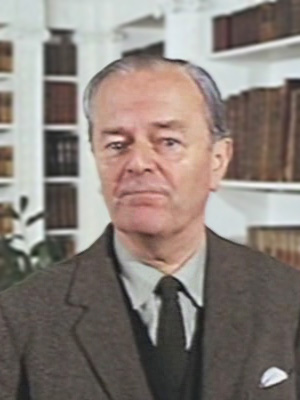Kenneth Clark
( Author, broadcaster, art historian) | ||||||||||||
|---|---|---|---|---|---|---|---|---|---|---|---|---|
 | ||||||||||||
| Born | Kenneth McKenzie Clark 13 July 1903 London, England | |||||||||||
| Died | 21 May 1983 (Age 79) Hythe, Kent, England | |||||||||||
| Alma mater | • Winchester College • Trinity College (Oxford) | |||||||||||
| Spouse | Elizabeth Jane Martin | |||||||||||
British art historian, museum director, and broadcaster.
| ||||||||||||
Not to be confused with UK politician Kenneth Clarke
Kenneth Mackenzie Clark, Baron Clark was a British art historian, museum director, and broadcaster. After running two important art galleries in the 1930s and 1940s, he came to wider public notice on television, presenting a succession of programmes on the arts during the 1950s and 1960s, culminating in the Civilisation series in 1969.
Background
He was in London as an only child in a wealthy family.[1]
Clark was educated at Wixenford School and, from 1917 to 1922, Winchester College. From Winchester, Clark won a scholarship to Trinity College, Oxford, where he studied modern history.[2]
Career
After coming under the influence of the connoisseur and dealer Bernard Berenson (Bernhard Valvrojenski), Clark was appointed director of the Ashmolean Museum in Oxford in 1931, aged twenty-seven. Three years later he was put in charge of Britain's National Gallery from 1934 to 1945. He was honorary professor at Oxford from 1946 to 1950 and 1961 to 1962.
In 1953 Clark became the Arts Council's chairman. He held the post until 1960.[2]
The year after becoming chairman of the Arts Council, Clark accepted the chairmanship of the new Independent Television Authority (ITA). It had been set up by the Conservative government to introduce ITV, commercial television, funded by advertising, as a rival to the British Broadcasting Corporation. Many of those opposed to the new broadcaster feared vulgarisation on the lines of American television,[3] and although Clark's appointment reassured some, others thought his acceptance of the post a betrayal of artistic and intellectual standards.[2]
Clark was no stranger to broadcasting. He had appeared on air frequently from 1936, when he gave a radio talk on an exhibition of Chinese Art at Burlington House; the following year he made his television debut, presenting Florentine paintings from the National Gallery.[4] During the war he appeared regularly on BBC radio's The Brains Trust.[4] While presiding over the new ITA he generally kept off the air, and concentrated on keeping the new network going during its difficult early years. By the end of his three-year term as chairman, Clark was hailed as a success, but privately considered that there were too few high-quality programmes on the network. Lew Grade, who as chairman of Associated Television (ATV) held one of the ITV franchises, felt strongly that Clark should make arts programmes of his own, and as soon as Clark stood down as chairman in 1957, he accepted Grade's invitation. Stourton comments, "this was the true beginning of arguably his most successful career – as a presenter of the arts on television".[5]
References
- ↑ https://biography.yourdictionary.com/kenneth-m-clark
- ↑ Jump up to: a b c http://www.oxforddnb.com/view/article/30934
- ↑ Stourton, James (2016). Kenneth Clark: Life, Art and Civilisation. London: Collins. p. 270
- ↑ Jump up to: a b https://web.archive.org/web/20180205190458/http://genome.ch.bbc.co.uk/search/0/20?order=asc&q=%22Kenneth+Clark%22
- ↑ Stourton, pp. 279–280